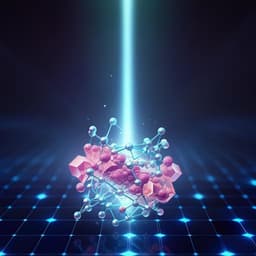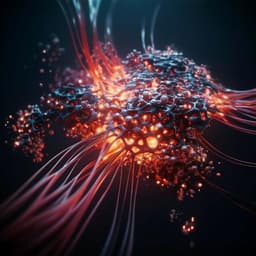
Chemistry
Degradation mechanism of hybrid tin-based perovskite solar cells and the critical role of tin (IV) iodide
L. Lanzetta, T. Webb, et al.
Discover the challenges posed by the stability of tin perovskites in photovoltaics. This study by renowned authors, including Luis Lanzetta and Thomas Webb, explores the degradation mechanisms of innovative 2D/3D tin perovskite films, revealing a cyclic degradation process influenced by moisture and oxygen. Learn how these insights could pave the way for greater stability in solar technology.
~3 min • Beginner • English
Introduction
The study addresses the stability challenges of lead-free tin halide perovskites, which are attractive alternatives to lead-based perovskites but suffer from rapid ambient degradation due to facile oxidation of Sn2+ to Sn4+. The central research question is to elucidate the degradation mechanism of hybrid tin-based perovskites, specifically (PEA)0.2(FA)0.8SnI3, under ambient conditions and to determine the role of tin(IV) iodide (SnI4) in initiating and propagating decomposition. The work seeks to understand whether SnI4 is merely a byproduct or an active intermediate that accelerates degradation via further chemical pathways, and how device architecture (notably the hole-transport layer, HTL) can mitigate degradation. Establishing these mechanisms is critical for designing strategies to enhance the environmental stability and performance of tin-based perovskite optoelectronic devices.
Literature Review
Prior studies on tin perovskites report air-induced decomposition pathways forming A2SnX6 (vacancy-ordered double perovskites) and SnO2, and oxygen-driven formation of SnI4 with release of organic cations (FAI/PEAI). Compared with extensive work on lead perovskites, mechanistic insights for tin analogues are limited. The literature indicates Sn2+ oxidizes readily to Sn4+, causing p-type self-doping and elevated non-radiative recombination. Approaches like SnX2 additives and low-dimensional (2D) phases improve stability but are incomplete solutions. Given SnI4’s known reactivity with H2O and O2, it has been hypothesized to participate in further degradation reactions. This work builds on these reports, interrogating SnI4’s downstream chemistry (hydrolysis to HI and subsequent oxidation to I2) and I2’s capacity to oxidize ASnI3, potentially driving a cyclic degradation process.
Methodology
- Materials and films: Prepared (PEA)0.2(FA)0.8SnI3 perovskite films from DMF/DMSO solutions with PEAI, FAI, SnI2 (commercial or thermally purified to reduce SnI4 impurities) and SnF2. SnI4 content was varied by (i) purifying SnI2 to reduce SnI4, and (ii) deliberately adding 2 mol% SnI4. Films were spin-coated and annealed. PMMA overcoats were used to trap volatile I2 in some tests.
- Structural and compositional characterization: X-ray diffraction (XRD) tracked phase evolution; X-ray photoelectron spectroscopy (XPS) quantified Sn4+ content; thermogravimetric analysis (TGA) assessed precursor purity; SEM examined morphology; profilometry measured film thickness (~250 nm).
- Optical and photophysical measurements: UV–Vis absorption monitored degradation (notably at 660 nm and 870 nm); steady-state and time-resolved photoluminescence (TRPL) (excitation at 404 or 635 nm) probed recombination dynamics.
- Chemical analysis of intermediates/products: 1H NMR (DMSO-d6) of degraded vs fresh films assessed water proton shifts consistent with HI formation; UV–Vis spectroscopy in toluene extracts detected SnI4 (~360 nm) and I2 (~300 and ~500 nm), with Na2S2O3 used to reduce I2 for confirmation.
- Controlled-environment degradation tests: Films were exposed to dry N2 (RH 0%), moist N2 (RH 90%), dry air (RH 0%), and moist air (RH 90%) in sealed cuvettes; absorbance at 660 nm was recorded every 5 min for 30 min to decouple O2 and H2O effects.
- Iodine-vapour exposure: Films were exposed to ~0.035% I2 (~350 ppm) for ~3 min; degradation products were extracted and analyzed by UV–Vis to test I2-driven oxidation.
- Device fabrication and testing: Inverted solar cells (ITO/PEDOT:PSS/(PEA)0.2(FA)0.8SnI3/PC60BM/BCP/Ag) were fabricated; J–V measurements under AM1.5G assessed the impact of SnI4 content on performance.
- Substrate/HTM dependence: Perovskite films were deposited on glass and ITO with NiOx, CuSCN, or PEDOT:PSS as HTMs; stability in ambient air was monitored by UV–Vis; steady-state and time-resolved PL assessed hole transfer (PL quenching).
- Computational methods: DFT (Quantum ESPRESSO, PBEsol for reaction energies; PBE+D3 for surfaces) calculated reaction energetics (including Gibbs free energies at 300 K via CRYSTAL17 harmonic approximation), O2 and I2 adsorption on FASnI3 (001) surfaces, bond lengths, and adsorption energies. Slab models with Sn/I and FA/I terminations were constructed with sufficient vacuum and dipole corrections; multiple adsorption configurations were relaxed.
Key Findings
- SnI4 forms as a primary product of oxygen-induced degradation of (PEA)0.2(FA)0.8SnI3 and coexists with SnO2 and released organic salts (FAI/PEAI) during early decomposition.
- DFT thermodynamics: Reaction of O2 with FASnI3 to form SnI4, SnO2, and FAI is highly favorable (ΔG ≈ −3.46 eV). O2 adsorbs on Sn/I-terminated surfaces (adsorption energy ≈ 0.7 eV), forming Sn–O bonds (Sn–O ≈ 2.31 Å) and elongating O–O by >0.1 Å, consistent with O2 activation and SnO2 formation. Formation of FA2SnI7 from SnI4 + FAI is weakly favorable (≈ −0.21 eV), consistent with delayed emergence.
- XRD kinetics: At room temperature, the (100) perovskite peak decreases markedly (73% drop after 60 min), while FA2SnI7 appears slowly (≈12% rise in its peak over the same time), indicating accumulation of SnI4/FAI precedes double-perovskite formation.
- SnI4 evolution to I2: 1H NMR shows water proton downfield shift (≈3.53 vs 3.35 ppm), consistent with HI formation via hydrolysis of SnI4 (SnI4 + 2H2O → 4HI + SnO2; ΔG° ≈ −0.60 eV). HI then oxidizes in air (4HI + O2 → 2I2 + 2H2O; ΔG° ≈ −2.20 eV). UV–Vis of toluene extracts from aged films shows SnI4 (~360 nm) and I2 (~300, ~500 nm); I2 features disappear upon Na2S2O3 addition.
- I2 oxidizes perovskite: Brief exposure to ~350 ppm I2 (~3 min) rapidly degrades films; UV–Vis of extracts shows SnI4 (~360 nm). DFT gives favorable energy for ASnI3 + I2 → SnI4 + AI (≈ −0.61 eV). I2 adsorption distorts the surface, forming bridge-like interactions and pulling Sn from coordination, consistent with oxidation to SnI4.
- Degradation environment dependence: No degradation under N2 (dry or moist). Dry air (O2 only) causes degradation; moist air (O2 + H2O) accelerates it substantially, consistent with the SnI4→HI→I2 pathway enabling a rapid cyclic mechanism. SnI4 converts to I2 in <10 min; I2 induces perovskite degradation in <3 min at far lower concentration than O2.
- Impact of SnI4 content on properties: Increasing SnI4 (as impurity or additive) increases Sn4+ content (XPS), widens optical bandgap slightly (from ~1.32 eV to ~1.35 eV), and shortens PL lifetimes (average τ: 5.49 ns for purified SnI2 film; 2.09 ns for as-received; 0.60 ns with added SnI4), indicating enhanced non-radiative recombination and p-type self-doping.
- Device performance: Champion PCE drops with higher SnI4. Purified SnI2: PCE 5.23%, Voc 0.61 V, Jsc 12.00 mA/cm2, FF 71%. With added SnI4: PCE 1.73%, Voc 0.55 V, Jsc 4.61 mA/cm2. SnI4-rich films degrade faster optically.
- HTM dependence: Stability trend under ambient exposure: ITO/PEDOT:PSS ≈ ITO/CuSCN > ITO/NiOx > glass. PL quenching indicates hole extraction yields of ~88% (PEDOT:PSS), ~82% (CuSCN), and ~18% (NiOx), correlating with enhanced stability, consistent with hole withdrawal reducing Sn4+ and mitigating oxidation.
Discussion
The results demonstrate that SnI4 is not only a degradation product but also a reactive intermediate that drives a self-amplifying, cyclic degradation process in tin perovskites. Oxygen initiates perovskite oxidation to SnI4, which in the presence of moisture undergoes hydrolysis to HI; HI is rapidly oxidized by O2 to I2, which then oxidizes the perovskite back to SnI4. This cycle explains the pronounced sensitivity of ASnI3 films to combined O2/H2O and rationalizes why exogenous SnI4 impurities accelerate degradation, as they shorten the pathway to I2 formation. The DFT surface adsorption and reaction energetics provide atomistic support for these steps, showing favorable O2 and I2 interactions with Sn/I-terminated surfaces and structural distortions consistent with oxidation. By modulating the interfacial energetics using hole-transport layers that efficiently extract holes, the films become more chemically reducing at the interface, likely converting Sn4+ to Sn2+ and slowing the oxidative cycle. Consequently, using effective HTMs (PEDOT:PSS, CuSCN) significantly improves film stability. These mechanistic insights directly address the research question and suggest practical strategies to mitigate degradation in tin perovskite devices.
Conclusion
This work elucidates a cyclic degradation mechanism in (PEA)0.2(FA)0.8SnI3 wherein O2 produces SnI4, which evolves through HI to I2, and I2 rapidly oxidizes the perovskite back to SnI4. SnI4 impurities degrade optoelectronic properties (shorter PL lifetimes, increased p-doping), lower device performance, and accelerate instability. DFT calculations corroborate the thermodynamics and surface interactions of O2 and I2 with the perovskite. Practically, reducing SnI4 content via precursor purification, blocking O2/H2O ingress, and employing HTMs that efficiently withdraw holes (PEDOT:PSS, CuSCN) improve stability. Future work should focus on: (i) scalable precursor purification and in situ Sn(0) or reductant strategies to suppress Sn4+, (ii) interfacial and encapsulation layers that block moisture/oxygen and scavenge I2, (iii) mechanistic studies of HTM/perovskite interfaces (passivation, defect chemistry), and (iv) extending the analysis to different A-cations and mixed-halide tin perovskites.
Limitations
- The DFT energetics used FASnI3 as a model system rather than the exact 2D/3D (PEA)0.2(FA)0.8SnI3 structure due to the lack of a well-defined crystal structure, which may introduce minor deviations in absolute energies while preserving trends.
- Interface-specific chemical effects (passivation, reactivity, defect formation) for different HTMs are not exhaustively analyzed and are left for future work.
- The optical and chemical analyses of intermediates focus on time windows up to tens of minutes (and fully aged samples for I2 capture); transient, short-lived species may be underrepresented.
- Device architectures were not optimized for maximum efficiency; performance metrics serve to illustrate the impact of SnI4 rather than set records.
Related Publications
Explore these studies to deepen your understanding of the subject.







